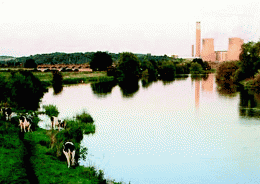Flooding of farmland does not increase levels of potentially harmful flame retardants in milk

As millions of acres of farmland in the U.S. Midwest and South recover from Mississippi River flooding, scientists report that river flooding can increase levels of potentially harmful flame retardants in farm soils. But the higher levels apparently do not find their way into the milk produced by cows that graze on these lands, according to a study in the ACS journal Environmental Science & Technology.
Iain Lake and colleagues note that the flame retardants, called PBDEs, are found in a variety of household products including furniture upholstery, textiles, cars, plastics, and electrical equipment. PBDEs "are increasingly being associated with endocrine disruption, neurotoxicity, reproductive and developmental toxicity, and potential cancer in animals studies," they write. Fatty foods such as milk and meat accumulate PBDEs, making those foods a potentially significant source of PBDEs consumed by humans.
Working along the River Trent in the United Kingdom, the researchers examined whether PBDE levels in the soils, grass, and milk obtained from grazing cows would differ between flood-prone and non-flooded farms along the river. While flood-prone fields contained significantly higher levels of PBDE from river sediments, this increase did not translate into higher PBDE levels in the grass growing in the soils. Moreover, "this study provides no clear evidence that the grazing of dairy cattle on flood-prone pastures on an urban and industrial river system leads to elevated PBDE levels in milk," Lake and colleagues write.
More information: “Effects of River Flooding on Polybrominated Diphenyl Ether (PBDE) Levels in Cows’ Milk, Soil, and Grass” Environ. Sci. Technol., 2011, 45 (11), pp 5017–5024 DOI: 10.1021/es2007098
Abstract
The first investigation into PBDE levels in food produced from flood-prone land on industrial river catchments was conducted. In August 2008 samples of cows’ milk, along with grass and soil were taken from 5 pairs of flood-prone and control farms on the River Trent (Central UK). The sum of 7 BDE congeners (28, 47, 99, 100, 153, 154, and 183) was calculated. Higher PBDE levels occurred in soil on flood-prone compared to control farms (median 770 vs 280 ng/kg dry weight). These higher levels were not reflected in the grass samples indicating that PBDE contamination on soils is not transferred efficiently to grass. This observation alongside the fact that cows on flood-prone farms spend time on non-flood-prone land and are fed substantial quantities of commercial feed are reasons why higher PBDE levels were not found in milk from flood-prone farms (median 300 vs 250 ng/kg fat weight). Similar BDE47/BDE99 ratios were observed in soil and grass samples compared to the PBDE product commonly used in the UK, indicating few differences in source-pathway transfer efficiencies between congeners. The BDE47/BDE99 ratio in the milk samples was greater than those in the grass and feed indicating differential food to milk transfer efficiencies between congeners.
Provided by American Chemical Society














